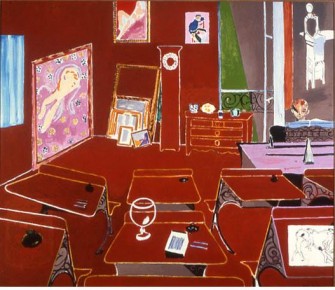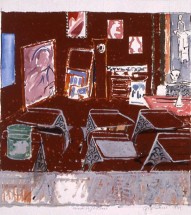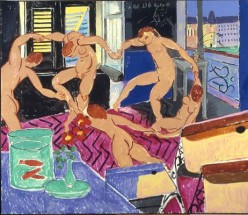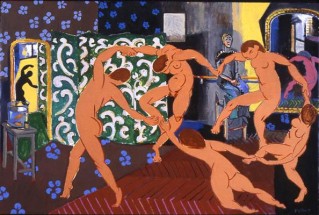| WorkSchool of Matisse 1
| Image Notes
Date of painting: 1988. Erroneously dated 1987 in Art School. Reference Henri Matisse, The Red Studio, 1911. Museum of Modern Art, New York. Henri Matisse, The Piano Lesson, 1916. Museum of Modern Art, New York. Henri Matisse, Woman on a High Stool, 1914. Museum of Modern Art, New York. While he almost, but not quite, went as far as a copy, George Deem (b. 1932) in 1987 (sic) followed Matisse's own lead as he converted The Red Studio into a classroom furnished with seven school desks which replace Matisse's foreground table and the furniture on the right-hand side of his picture. The constructed space, however, corresponds exactly to that of Matisse's picture of 1911. And, like Matisse, Deem made the red surface plane signify both pictorial space and furniture at the same time. Moreover, the pictures represented by Matisse on the left-hand side of his painting are found again in Deem's painting. When one has moved beyond the surprise of recognition, one realizes the American painter's essential alterations. For behind the school desks, which occupy almost half the picture plane, a grand piano has been inserted as well, at which a young boy is seated ready to play. Here Deem has integrated another picture by Matisse into his work, namely, The Piano Lesson of 1916. The composition of The Piano Lesson is mostly preserved intact by Deem's collaging technique; he forcibly combines his two chosen models of pictorial invention in such a way that the chest of drawers in The Red Studio's very center now fuses the two prototype images together. A distinction between their respective pictorial realities is no longer discernible. Here Deem emulates Matisse who himself in The Piano Lesson did not allow the viewer to perceive that the woman on the high stool is a representation of a painting from 1914. Matisse turned the woman in that picture into a stern piano teacher, if one may so interpret the figure's severe form in this new context. Now -- under Deem's direction -- she dominates an entire classroom from an insuperable distance, even if only one single boy is present, subservient to the authority of the metronome. When Deem, without lapsing into banality, ironically deflects the seriousness of The Red Studio, he above all needs a viewer who is familiar with his pictorial sources. The artist has to presume familiarity with those sources so that their refraction in his work may be recognized and his own picture become manifest. Deem actually works in just such a manner, making use of artworks which enjoy a high degree of recognition, in other words, masterpieces, such as he hereby affirms The Red Studio to be. (Werner Schnell, Das Rote Atelier des Henri Matisse: ein Bild und seine Verwandten. Footnotes omitted. See bibliography. Translated from German by Ronald Vance with the assistance of Christiane Hertel and Joan Reutershan). | Artist's Notes| ExhibitionsEvansville Museum of Arts and Science, Evansville, Indiana |
Works
| WorkSchool of Matisse 1
| Image Notes| Artist's Notes| Exhibitions |




